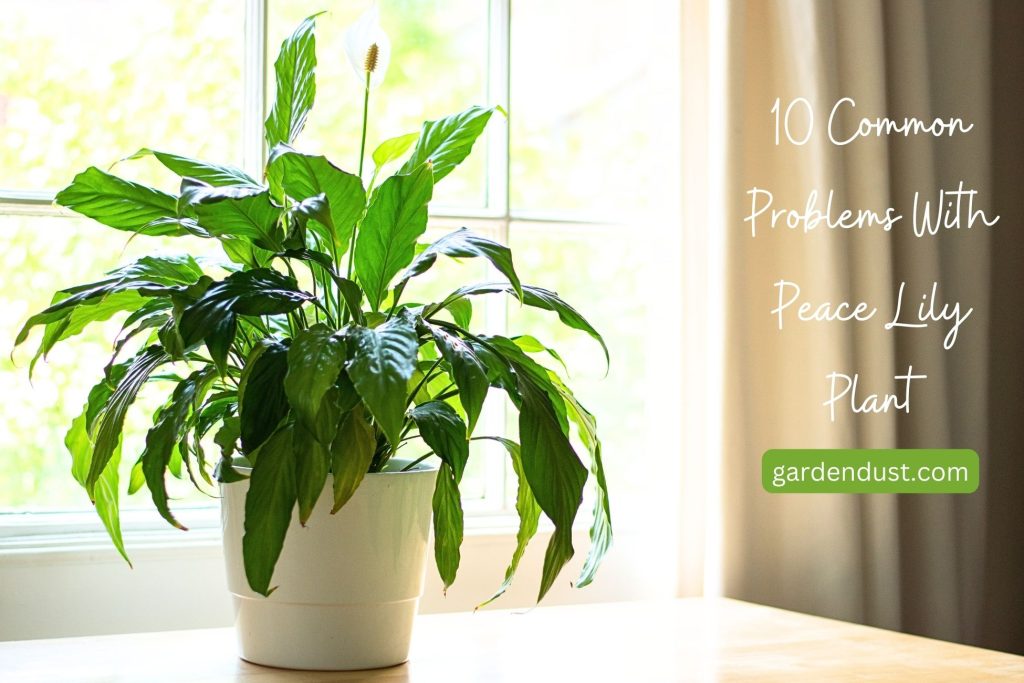The Peace Lily (Spathiphyllum), with its elegant white blooms and glossy green leaves, is a popular indoor plant known for its air-purifying qualities and adaptability. However, even the most resilient plants can encounter issues. In this article, we will delve into 10 Common Problems With Peace Lily Plant.That owner might face and explore detailed solutions to help you maintain a thriving and healthy plant. Let’s begin…
- Botanical Name: Spathiphyllum spp.
- Native: Tropical regions of Central and South America.
- Genus: Spathiphyllum
- Family: Araceae
- Common Name: Peace Lily
- Plant Type: Perennial, herbaceous
- Flower: Peace Lilies produce a unique inflorescence called a spathe, which is a white, hood-like structure, surrounding a spadix.
- Blooming Time: Peace Lilies typically bloom throughout the year, with their peak flowering period in spring and early summer.
- Plant Growth: Moderate growth rate, reaching a height of 1 to 4 feet, depending on the species and variety.
- Leaves: Glossy, lance-shaped leaves with a prominent midrib, arising directly from the soil. The foliage is typically deep green.
- Sun Exposure: Peace Lilies thrive in indirect or filtered light. They prefer bright, indirect light but can tolerate lower light conditions. Direct sunlight should be avoided.
- Water Requirement: Keep the soil consistently moist but not waterlogged. Allow the top inch of the soil to dry out before watering again. Peace Lilies are sensitive to overwatering, so it’s essential to maintain a well-draining soil.
Common Problems With Peace Lily Plant-
1. Yellowing Leaves
Yellowing leaves are a prevalent issue with Peace Lilies and can be caused by various factors. Overwatering or underwatering, exposure to direct sunlight, or poor soil quality may contribute to this problem. To address yellowing leaves, ensure that your Peace Lily is in well-draining soil, adjust your watering frequency, and place the plant in indirect light.
2. Brown Leaf Tips
Brown tips on Peace Lily leaves are often a sign of low humidity levels. Increase humidity by misting the plant or placing a tray of water near it. Additionally, make sure the plant is not exposed to drafts or direct heat sources, as these can lead to moisture loss from the leaves.
3. Root Rot
Overwatering is a common cause of root rot in Peace Lilies. To prevent this, allow the soil to dry out between watering’s and ensure proper drainage. If you suspect root rot, gently remove the plant from its pot, trim affected roots, and repot it in fresh, well-draining soil.
RRAD ALSO:-9 Common Problems When Growing Hydrangea
4. Wilting
Wilting can result from both overwatering and underwatering. Check the soil moisture regularly and adjust your watering routine accordingly. If the soil is consistently soggy, reduce watering frequency; if it’s dry, increase it. Wilting can also occur if the plant has outgrown its pot, so consider repotting if necessary.
5. Pests: Spider Mites and Aphids
Spider mites and aphids are common pests that can infest Peace Lilies. Keep an eye out for webbing, discolored leaves, or tiny insects. Use insecticidal soap or neem oil to treat infestations, and consider isolating the plant to prevent the pests from spreading.
6. Brown Spots on Leaves
Brown spots can be a sign of bacterial or fungal diseases. Avoid overhead watering to prevent the spread of pathogens, and ensure good air circulation around the plant. If brown spots persist, treat with a fungicide or bactericide according to the product’s instructions.
7. Failure to Bloom
Peace Lilies are known for their striking white blooms, but if your plant fails to flower, it may be due to insufficient light. Place the plant in a location with bright, indirect light, and avoid keeping it in complete darkness. Additionally, provide a balanced, water-soluble fertilizer during the growing season to encourage blooming.
8. Yellowing of Older Leaves
It’s normal for older leaves to turn yellow and die off as new growth appears. However, if this occurs at an accelerated rate, it may indicate a nutrient deficiency. Feed your Peace Lily with a balanced liquid fertilizer to provide essential nutrients and promote healthy foliage.
9. Leaves Drooping Despite Adequate Watering
If your Peace Lily’s leaves are drooping even though the soil is consistently moist, the plant may need more humidity. Increase humidity levels by misting the leaves regularly, placing a humidifier nearby, or grouping plants together.
10. Stunted Growth
Stunted growth can be attributed to various factors, including inadequate light, poor soil fertility, or overcrowded roots. Ensure your Peace Lily receives sufficient indirect light and feed it with a well-balanced fertilizer during the growing season. If the plant has outgrown its container, consider repotting to provide more space for root development.
While Peace Lilies are generally resilient and adaptable, addressing common problems promptly is crucial for maintaining a thriving indoor garden. Regular monitoring, appropriate watering, proper lighting, and proactive pest management are key factors in ensuring the health and longevity of your Peace Lily. By understanding and addressing these 10 common issues, you’ll be better equipped to enjoy the beauty and benefits of this popular indoor plant. Happy Gardening….







